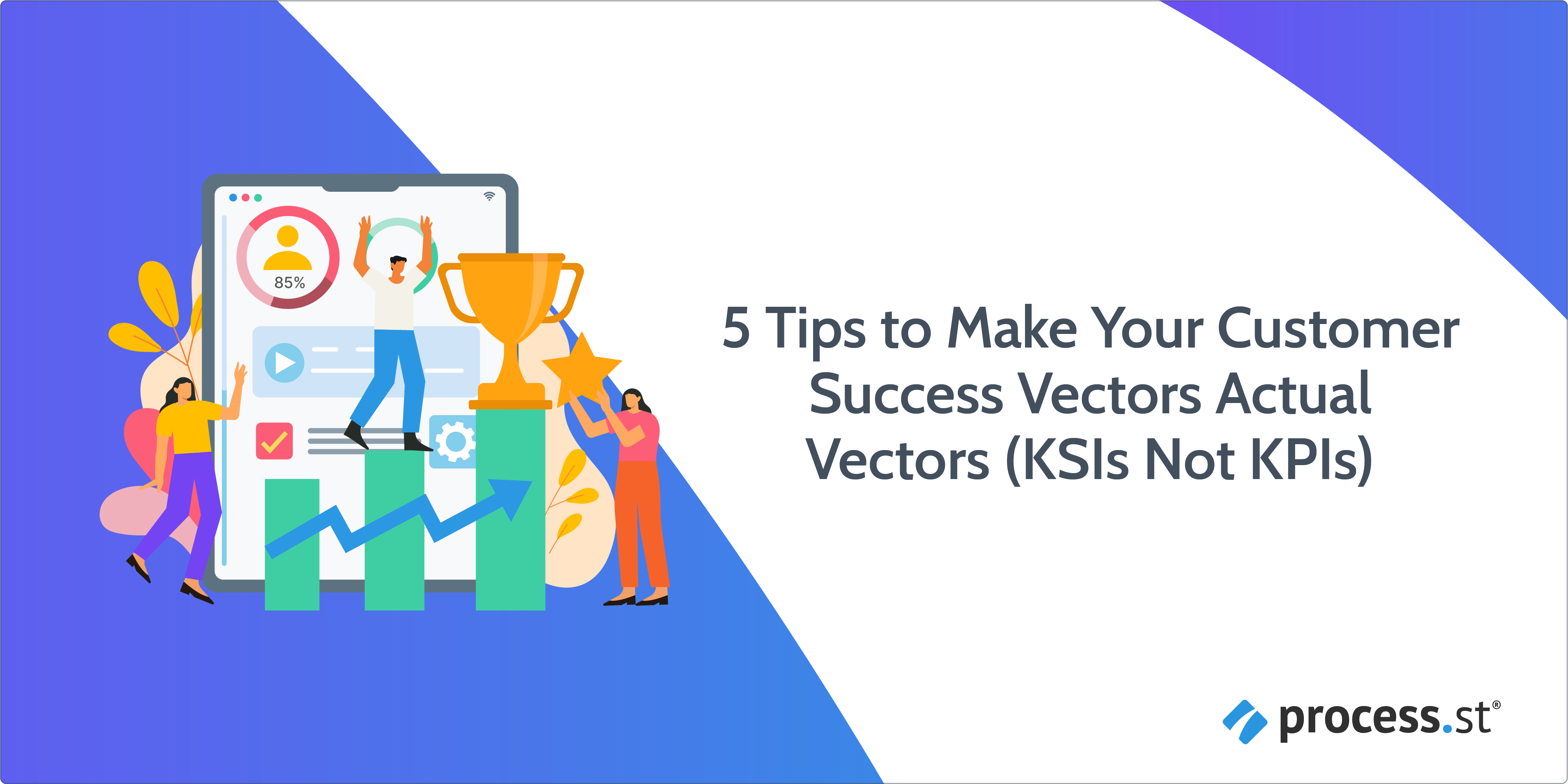
79% of marketers state customer experience strategies need to focus on customer retention. Yet, according to McKinsey and Company, there’s too much focus on churn reduction with a lack of consideration on what the customer wants.
When thinking about common metrics used in customer success – e.g. customer health scores – these are in-the-moment snapshots designed to communicate the likelihood of churn. They do not consider what it is the customer wants to achieve and whether they are on track to achieve this. To do this, you need customer success vectors.
A customer success vector gives the here-to-here journey a customer has with you, detailing where they are at today, where they will be tomorrow, and where they want to go.
In this Process Street article, I’ll explain what a customer success vector is, and why you need to supplement your customer experience metrics with vector measurements. You’ll learn how to ensure your customer success vectors are actual vectors with my 5 top tips. By the end of this article, you’ll be able to leverage success vector results to drive growth from the customer’s perspective, and consequently, from the perspective of your bottom line.
- Customer health score: Moving from a customer success KPI to a KSI
- Customer success vectors describe the customer’s maturity and where they’re heading
- 5 tips to ensure your customer success vectors are actual vectors
Customer health score: Moving from a customer success KPI to a KSI
The customer health score is a metric determining whether a customer is at risk of churn or not. It’s a measure giving a time snapshot of an account’s health.
The larger the health score, the higher the account’s value and the greater the likelihood the customer will be a repeat customer.
If you read my previous article – How to Have a Customer Health Score Beyond Just NPS (Which We Know 46% of You Use!) – then you’ll know all about the customer health score metric and how to calculate it.
However, calculating customer health scores – and other snapshot customer success metrics – shouldn’t be your only priority as a customer success professional. Customer success metrics are lagging indicators. Therefore you need to supplement these measures with more forward-looking calculations.
This is where customer success vectors come into the picture.
The difference between KSI/customer success vectors all comes down to that one term, vector.
“A vector is a quantity that has direction as well as magnitude, especially as determining the position of one pointing space relative to another.” – Lexico, Vector Definition
Before moving forward in this article, we’re going to rack our brains back to high school mathematics, and remind ourselves of vector measurements.
Understand that vectors are measurements with both direction and magnitude
A vector holds two pieces of information: Direction and Length (also referred to as magnitude).
The direction explains where the vector is pointing and will have two points, a starting point, and a finishing point. The magnitude describes how fast we’re moving to our desired position.
Vectors are visual pieces of content, usually mapped on a graph.
For more information about vectors, watch the video below for more information.
The important takeaway here is that we need two values to be able to construct a meaningful customer success vector:
- Direction (or in other words, a start point and an end point). What are your customer’s goals for success (desired outcome)?
- Magnitude (i.e. the distance between the two points as a reflection of the customer’s experience, either positive, negative, or neutral) & what needs to be done to get them from point A to point B?
Using vectors in customer success
Customer success vectors determine whether you’re on track to hit the growth potential of your existing customer base. They tell you where your customer is and where your customer is heading, which is appropriate in customer-driven growth.
You want your customers to be heading towards growth!
Your customers are going to evolve, and it’s your job to ensure your customers can grow with you. For this, you need to be clear about your desired outcomes for each of your discrete customer segments.
To explain this further, let’s look at a real-life scenario.
Customer success vectors describe the customer’s maturity and where they’re heading
If you’ve stalked my previous work , you’ll know that I used to work for an environmental testing laboratory. I was part of the customer success team, handling technical requests given by clients. It was my job to oversee specific accounts, making sure the laboratory was helping them reach their goals by using the testing service we provided.
Let’s consider two accounts under my charge.
Both accounts had the same customer health score measures (KPIs), but different fundamental challenges. Both were large enterprises, headquartered down south, with whom the laboratory had good relations for multiple years. The enterprises were comparable in size, geography, and stage.
Customer 1 was a waste, water, and energy management organization. The organization helped businesses reduce their environmental impact through infrastructure investments and waste removal.
Key criteria for their high customer health score included:
- A high input of environmental samples to be tested by the laboratory.
- Excellent relationships between Customer 1’s team and the laboratory’s team.
- Excellent support statistics that exceed the SLA for sample turnaround times.
- Ongoing project expansion.
♂️ Customer 2 is an environmental consulting service focused on providing accurate information to a large set of businesses regarding their environmental performance. They utilized the laboratory as a middle-man resource, to test samples given to them by their clients. Test results were then translated by the consultancy to their clients.
Key criteria for their high customer health score included:
- A high input of environmental samples to be tested by the laboratory.
- Excellent relationships between Customer 2’s team and the team at the laboratory.
- A track record of project expansion with the laboratory.
- Solid support statistics and CSAT.
The two companies had equal customer health score measures, yet they were dramatically different in terms of how the laboratory could assist them in meeting their growth goals. Therefore, as a customer success representative, I used different strategies for the two.
This difference had little to do with the customer’s relations with us (health score) and a lot to do with the maturity of business management – where they are relative to where they are going. The two organizations also differed in how they planned to reach their goal, as I will explain.
♀️ Customer 1:
- Operated from multiple offices nationwide.
- Worked with a range of different businesses.
- Grew via R&D to expand their service.
- Their teams – not least because of the different service specialization – had varying degrees of technological understanding and capabilities.
- They invested a significant amount of energy in consolidating their business, using different systems, technologies, teams, customer types, and operating procedures, etc.
My efforts as a customer success representative focused on helping customer 1 adopt the laboratory’s service, for them to be successful in delivering the customer’s needs.
To meet the varying degrees of technological understanding from their team, I had to stress different features to different business units. Some needed only basic sample testing, whereas other units were further along regarding their relationship with us, and had complex testing quotas to meet.
♂️ Customer 2:
- Operated in a single office.
- Consulted for multiple businesses.
- Had a strong team of highly professional environmental consultants. This team had advanced technological knowledge, knew what they wanted, and had a plan of action to get to their goal.
- Customer 2 was pushing the laboratory regarding their testing requirements, service levels, and testing execution.
Helping Customer 2 succeed and grow with us as a laboratory needed careful relationship management, addressing ever-increasing demands. We regularly visited Customer 2 on-site and produced joint Quarterly Business Reviews (QBRs). These reviews focused on numerically quantifying past results, as well as facilitating deep discussions about testing and service expansion.
As long as we paid close attention to managing our relationship with this client, the backlog of potential new projects to expand their work with us kept growing. Customer 2 derived more value from the laboratory’s solutions, meaning the laboratory, in turn, increased revenue from them.
As you can tell, Customer 1 and Customer 2 were heading in different directions in terms of what they wanted to achieve via using the laboratory’s service. Once more, the two customers had different capabilities, meaning how they were going to achieve their desired outcome – what they needed from the laboratory – differed. This clear distinction would be lost with a single KPI measure, such as a customer health score.
As a customer success representative, if I used an equal strategy for Customer 1 as I did Customer 2, it’s unlikely that Customer 2 would receive their needs from the laboratory, and they would not meet their goals. Customer success vectors, in contrast, would capture information separating the two customers, for different customer success strategies to be applied.
5 tips to ensure your customer success vectors are actual vectors
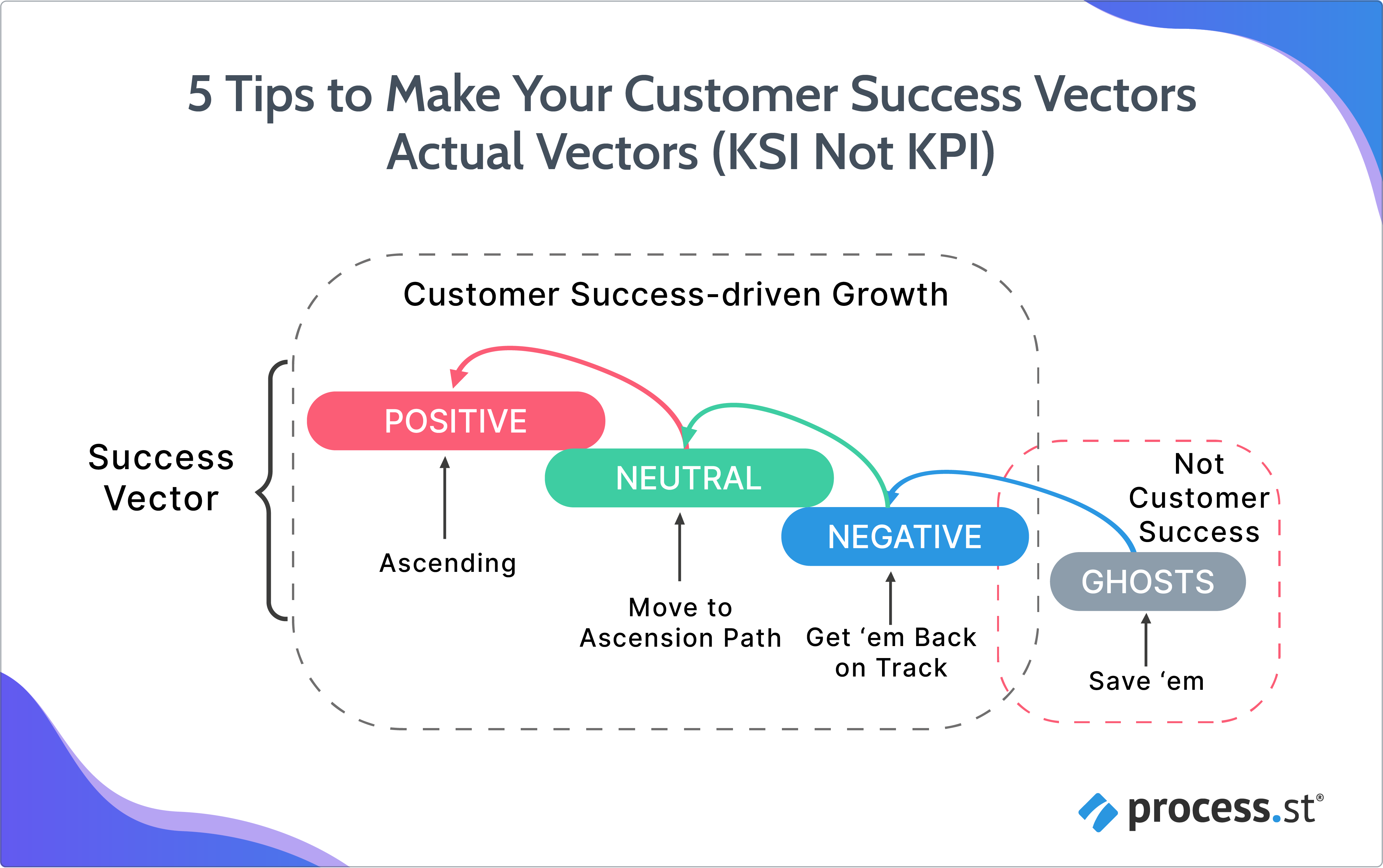
Vectors are essentially mathematical measurements for moving objects. To apply this in the context of customer success, the moving object we’re referring to is the customer.
Thinking about vectors in customer success is useful because two customers may have the same, say customer health score, but they’re likely working towards different goals (directions). This means they’ll need a different focus from the customer success team.
Understanding what we mean by customer success vectors, and why they’re useful, begs the next question: How do you make sure your customer success vectors are actual vectors?
I’ve summarized the answer to that question in 5 simple steps below.
Step #1: Understand what information can be obtained from a customer success vector
Using business KSIs as opposed to KPIs (aka the customer health score) in customer success gives a measurement that has both a direction and magnitude, as explained:
- Direction: What does your customer need to achieve? Where is your customer going? Otherwise known as the desired outcome.
- Magnitude: How will your customer achieve this? What does the customer have to do to achieve their goal? What is their experience with you as a service? These will all impact the resources, time, and/or money – aka the magnitude of work to be done – needed to get your customer to their desired outcome.
Your customer’s desired outcome consists of two pieces of information: The appropriate experience and the required outcome.
- Required outcome: This is what your customer needs to achieve. There are a few things that must happen. Otherwise, you know your customer can’t reach their desired outcome – there will be no vector as your customer can’t possibly move from point A to point B.
- Appropriate Experience: This is how your customers need to achieve their required outcome, taking customer satisfaction, confidence, and support interactions into consideration.
Together these two measures make up the core of your customer success vectors and will tell you if your customer is on track or heading for the door.
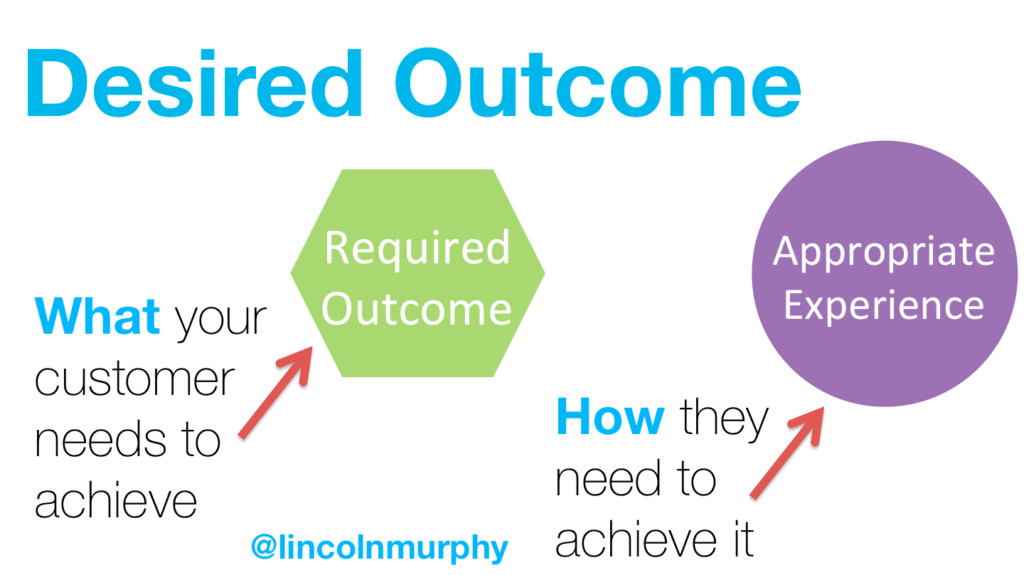
The only time you can use the same customer success strategy on two separate customers is when they have equal desired outcomes (with the same required outcomes and appropriate experiences). In that case, the customers would have equal success vector measurements. This is highly unlikely.
Step #2: Measure the appropriate experience
Any vector needs a magnitude. You can think about the appropriate experience as a collection of measures determining – along with the required outcome – the effort needed to take a customer to their desired outcome (vector magnitude).
For instance, you can determine a customer’s appropriate experience by measuring customer satisfaction and confidence. How satisfied are your customers with you?
Here you could draw from your customer health score measures which incorporate customer satisfaction determinants, e.g. NPS score and CSAT.
If your customers are not satisfied with your current offering, this will hinder their relationship with you.
Low customer satisfaction and confidence scores mean you have work to do to establish a healthier relationship. Factor this work in during the early stages of your customer’s journey with you.
Use our Customer Feedback checklist to gauge your customer’s satisfaction and confidence level.
Key checklist feature: Form fields are used to collect and document customer feedback information. This information is securely stored. You can then use our Task Permissions feature to control who can view this information, which can be accessed at any time from anywhere.
Click here to access our Customer Feedback checklist!
Tip #3: Measure the required outcome for your customers
What do your customers want to achieve? Where are they heading with you? How are they growing with you?
You need to determine whether accounts are making progress towards their goal, and evaluate whether they’re doing what they need to do. This information is captured in the required outcome.
Complete the below steps to determine whether your customers are fulfilling their required outcomes.
#1: Determine your customer’s success potential
Is it possible for your customer to meet their desired outcome with you? What is your customer’s success potential?
You can determine a customer’s success potential by defining their:
- Technical fit: Technical fit refers to the technical abilities, skills, and experience of your customer. Is it technically possible for your customers to meet their desired outcome? Are they using, don’t have, or can’t/wont acquire a key piece of technology?
- Functional fit: Is your product/service missing a key piece of functionality for your customer?
- Resource fit: Are your accounts able to invest – beyond paying a fee – in what’s required to be successful as a customer?.
- Competence fit: Does your customer have, or will they acquire, the expertise internally required to be successful?
- Experience fit: Do your accounts have the internal experience needed to meet their desired outcome? If not, are they willing to source or train this experience to be successful in using your service/product?
- Cultural fit: The last success potential factor looks at you and your customer’s ability to gel together – those that gel together, work well together. Does your customer have complementary beliefs, morals, and attitudes? A culture clash could halt progress.
Your customers need to meet the above success potential criteria for them to achieve their desired outcome. If your accounts do not tick a specific success potential criteria, then you’ll need an action plan to resolve this.
Without ticking all of the above criteria, the magnitude of work you’ll have to do for that customer will be too great/outside the scope of your offering. These are bad customers and, as accounts, they’re not worth pursuing. These accounts are classed as ghost success vectors, ghosts because they don’t exist. They can’t reach their required outcome with you to move from point A (where they’re at now) to point B (desired outcome).
#2: Determine success milestones
Success milestones map account progress towards their goals. Some of your success milestones will have logical upsell or advocacy opportunities associated with them.
Useful note: You can look at the success milestones to accurately predict revenue. For instance, say 100 customers will reach X success milestone in the next month. That success milestone has a logical upsell associated with it. You can determine the percentage of customers that should take the upsell based on their success vector to predict revenue growth – as you’ll see under step #5.
A success milestone could be anything from the customer signing up to a free trial (this would be an early stage milestone), to a customer upgrading to a premium version of your service.
But your success milestones aren’t about you, they’re about your customer.
If upgrading to a premium version doesn’t align with a customer’s required outcome, then this would not be an appropriate success milestone.
I recommend mapping the success milestones on your customer’s journey map to give perspective.
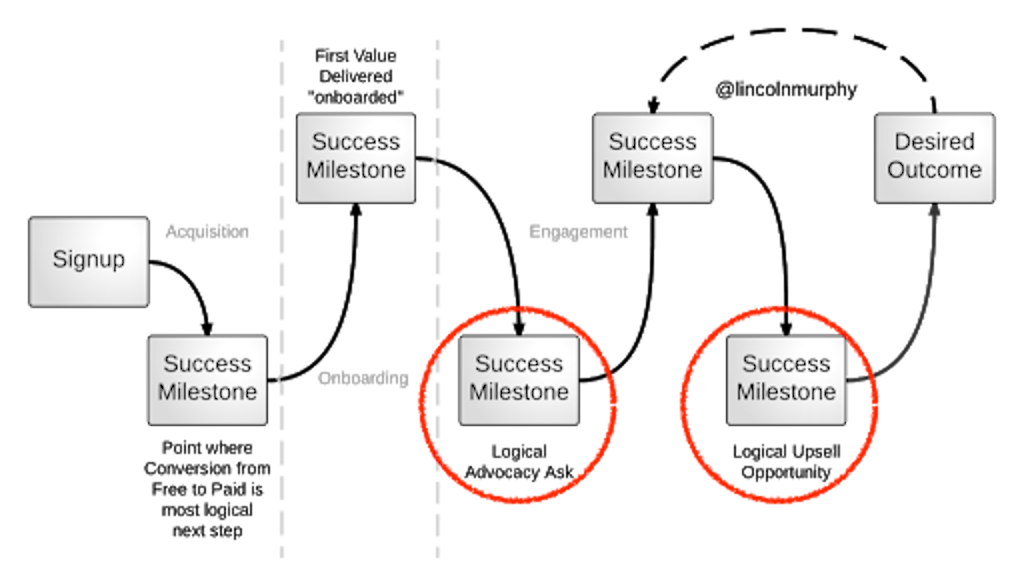
Use Process Street’s Customer Journey Map Template to oversee your customer’s experience with your business. Mark success milestones at the different journey stages.
Key checklist feature: Approvals ensure the mapped customer journey for your key accounts is accurately accessed by senior customer service representatives. This certifies accuracy for your customer journey mapping process, so mistakes don’t seep through. With an accurate journey map, success milestones can be marked.
Click here to access our Customer Journey Map Template!
#3: Joint accountabilities
Your customers need to take accountability for the role they play in meeting their goals. Be sure to communicate this to your customers.
Defining joint accountability is easy using Process Street. You can document the steps you want your client to take in a Process Street workflow. Then, using Process Street’s shared checklist link feature, send these workflows to your customers. Your customer can open the checklist, complete the tasks, and BAM! They’ve completed the necessary steps moving them towards their goals (their desired outcome).
[Salesforce Datorama sends…] “shared checklist links to clients when they reach out to us, giving us a reactive approach, not a proactive one… As a point though, using the checklist run links ensures we’re continually engaging with the clients while also giving them independence.” – Alex Hauer, Salesforce Datorama
Learn how Salesforce Datorama uses Process Street to provide joint accountability by watching the video below:
Step #3: Determine an account’s ascension velocity
The ascension model describes customer movement from lower costing, less profitable products/services, to higher costing, more profitable ones.
It’s recommended to include the ascension model in your sales funnel. This means providing something free in your funnel, something cheap, something not so cheap, something expensive, something really expensive, and something really really freakin’ expensive.
The idea is to guide your customers through your sales funnel, helping them meet their milestone goals as they go. The ascension velocity refers to how quickly your customers move through this funnel.
If an account has a high ascension velocity, this means they are taking logical upsells and recognize a value use case for your product/service offering. Such accounts are likely to have a positive success vector result.
Tip #4: Respond appropriately depending on the customer KSI measure
Your customer success strategy will differ depending on whether you define your accounts as having positive, neutral, negative, or ghost success vectors. These four categories are explained:
- Positive success vectors: Accounts are not static but progressing towards their desired outcome. They’ll meet the success potential criteria, and are satisfied with your product/service. These accounts are meeting required outcomes with a solid appropriate experience, pushing them towards their desired outcome.
- Neutral success vectors: These accounts have stalled or stagnated. You’ll need to get these accounts back on track to achieving their desired outcome and on a logical ascension path. Look into their appropriate experience, are they satisfied with the service your offering? Are they meeting their required outcomes? Do they check every success potential? Find out the root cause of their neutral vector.
- Negative success vectors: These accounts are not on the right track and need urgent intervention. They are withdrawing their use with you. They are traveling backward, hence the negative vector.
- Ghosts: These accounts are highly likely to churn. Your key contacts have stopped engaging or responding. We’re moving outside the realms of customer success, as strategies employed must focus on churn prevention. It’s likely these customers are bad customers and don’t check off your success potential criteria. Before using both time and effort to prevent these accounts from churning, ask yourself, is it worth it? Or is it worth your time and energy focusing on accounts traveling along a positive track?
Your aim is for your entire account base to have a positive success vector associated. At first, you’ll have accounts in each category. But as you continue to use the KSI approach, you can orchestrate and operationalize your customer success management processes to the point where you have positive success vector outcomes.
If you’re starting out integrating this success vector philosophy into your business using KSI’s, there’s a good chance that you’ll have customers that have gone dark, aka, the ghosts.
You can run our Churn Prevention Checklist for your ghost accounts to prevent them from canceling their service with you.
Key workflow feature: Stop Tasks ensure all essential steps in the churn prevention process are carried out. This is important, as missing a critical step could make the difference between keeping a customer and losing one. The workflow cannot be completed until all tasks are done.
Click here to access our Churn Prevention Checklist!
In terms of your negative and neutral customers, begging, promising, and discounting have nothing to do with helping these accounts achieve their desired outcome.
True customer success would have ensured these accounts never reached this point in the first place.
Tip #5: Visualize your success vector
To make sense of your success vectors, (to visualize them as positive, neutral, negatives, or ghosts), one method would be to map these vectors on a graph.
As one suggestion, have time on the x-axis, and revenue generated on the Y-axis.
If you’ve employed an ascension model for your sales funnel, your customer success milestones will be associated with incremental revenue increases for you as a business. E.g. milestone 1 might be for a customer to move from a free trial to a paid version of your service. The customer will move through each success milestone until they reach their final milestone, their desired outcome, which will have a predicted revenue associated. Your Y-axis is capturing the direction of your success vector, which in this case, is captured by the revenue generated.
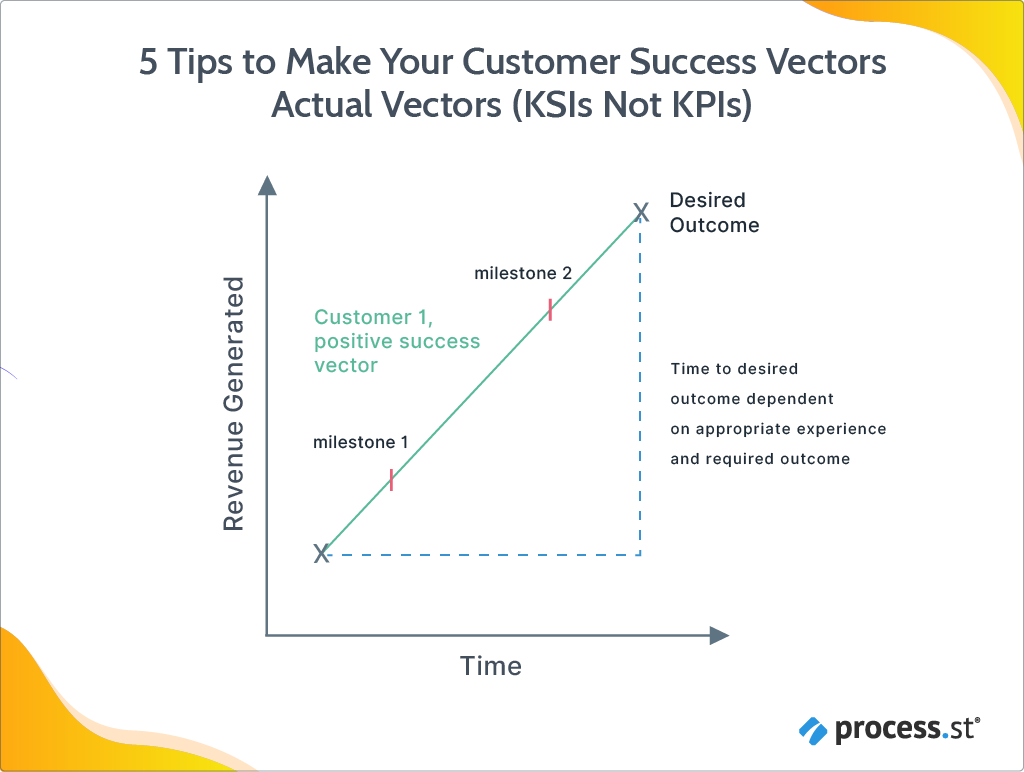
Measuring time on your x-axis reports the effect of appropriate experience and required outcome on your success vector. That is, the better an account’s appropriate experience, the less time it will take them to reach each milestone. In addition, if an account is meeting its required outcome, less work is needed to take that customer to their desired outcome.
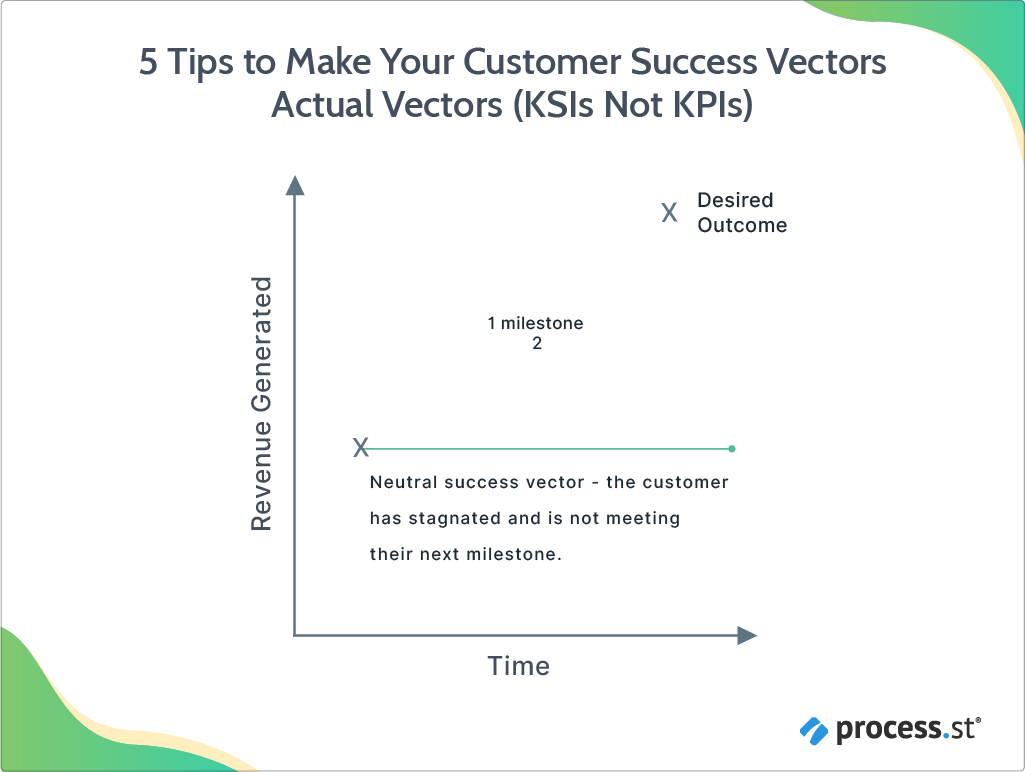
If you’re dealing with a large variation in revenue generated, this could make it difficult to graphically represent your entire customer base on the same chart. I suggest you group your customers as per the revenue category. With your higher-value customers grouped, you can use graphs of a similar scale capturing larger revenues. Smaller revenues can then be captured using a separate graph.
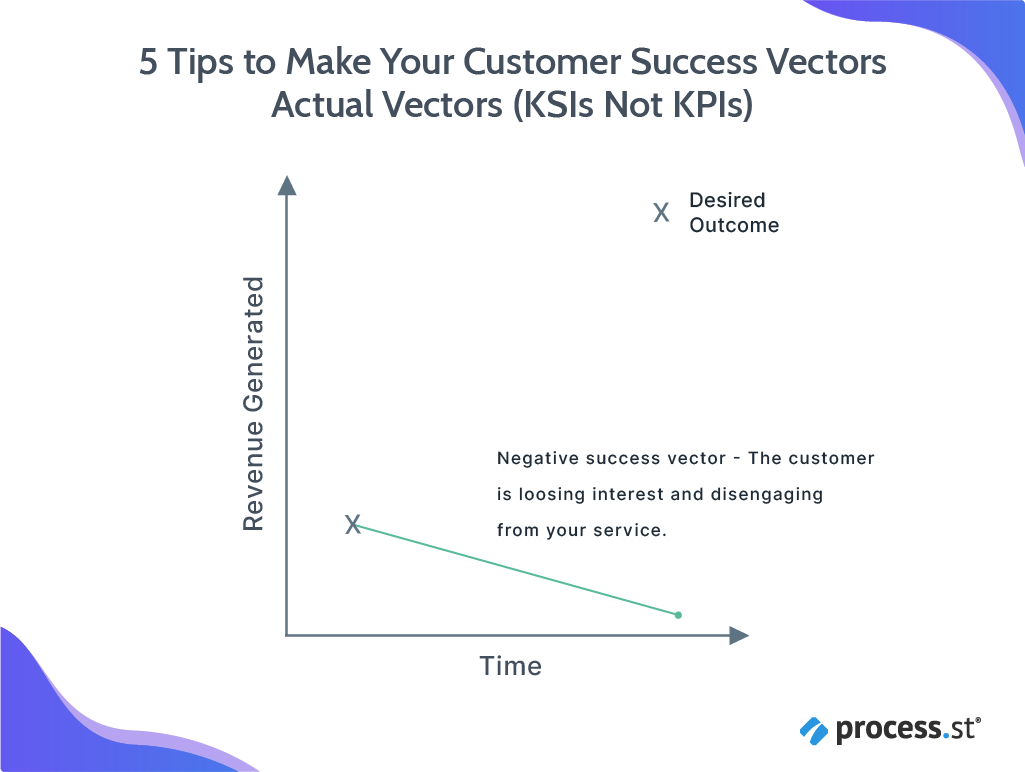
With customer success vectors, you’ll understand whether your customers are heading towards their goals
Your customer success team is the growth engine of your business. With snapshot KPI metrics, such as customer health scores, you cannot capture and visualize customer growth. You need measures that have both direction and magnitude, that capture customer growth information from here to here. By growth, we’re talking about business growth that’s based on what the customer wants.
This article is your introduction to customer success vectors, explaining how you can ensure your vectors are actual vectors.
Further reading: Customer-Centric Growth expert Lincoln Murphy’s take on the customer success vector concept, Success Vector – a Better Customer Health Score.
Do you use customer success vectors? How do you ensure your customer success vectors are actual vectors? How has transferring to customer success vector use helped you and your business? We’d love to hear from you in the comments below!







Jane Courtnell
Hi there, I am a Junior Content Writer at Process Street. I graduated in Biology, specializing in Environmental Science at Imperial College London. During my degree, I developed an enthusiasm for writing to communicate environmental issues. I continued my studies at Imperial College's Business School, and with this, my writing progressed looking at sustainability in a business sense. When I am not writing I enjoy being in the mountains, running and rock climbing. Follow me at @JaneCourtnell.